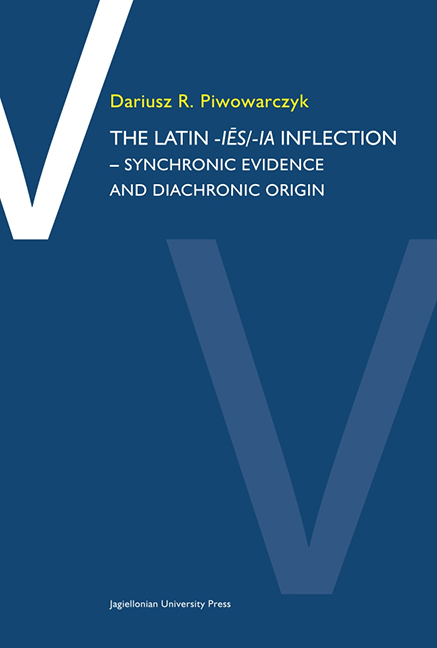Chapter two - The Latin fifth declension
Published online by Cambridge University Press: 16 July 2022
Summary
The Latin fifth declension has been the subject of research ever since the beginning of Indo-European linguistics (cf. Pedersen 1926 for earlier studiēs, Leumann 1977: 285, 444-447, Klingenschmitt 1992: 127-135, Meiser 1998: 147-149). Scholars tend to view this type of inflection either as directly inherited from Proto-Indo-European (Brugmann 1888: 313-314, Pedersen 1926, Schrijver 1991: 379-387, Kortlandt 1997, Beekes 2011: 199) or as an inner-Italic creation (Osthoff 1884: 338, Sommer 1914: 394-402, Steinbauer (undated) apud Mayrhofer 1986: 133-134, Klingenschmitt 1992: 127-135, Nussbaum 1999, Piwowarczyk 2017a).
The two most commonly used forms in this declension -diēs, -ēī ‘day’ and rēs, -ĕī ‘thing’ – are clearly not original *ē-stems. The former most probably comes back to a hysterokinetic u-stem with the acc. form being the only directly inherited one from Proto-Indo-European (cf. WH: I 349-351, EM: 311-313, Leumann 1977: 356-358, Weiss 2009: 253-255, Nussbaum 1999, Rau 2010). The latter could go back to an i-stem *(hx)reh1-i-s (cf. Weiss 2009: 253-255, Meiser 1998: 148, WH: II 430-431, EM: 1008-1009, Mayrhofer 1976: 45-46) or a root noun *(hx)reh1- (cf. Schindler 1972a: 41). Both formations would eventually develop into the same form in Latin (cf. de Vaan 2008: 520-521, Szemerényi 1956). The etymology of the rest of the words declining according to this type – plēbēs ‘people,’ fidēs ‘ faith,’ spēs ‘hope’ – remains unclear. Perhaps they go back to the proto-forms: *speh1- or *spēh2, *bhidh-ei and *pleh1-dhu̯-es respectively (cf. Meiser 1998: 148-149, de Vaan 2008: 580, 218-219, 471 and Piwowarczyk 2017a for all the mentioned forms respectively).
Apart from these forms, there are also numerous abstract formations in -iēs of the type: aciēs ‘sharpness’ and also abstracts in -iēs/-ia (māteriēs ‘matter, wood’) and -itiēs (nōtitiēs ‘acquaintance’) which have the alternating forms of the first declension (ie. respectively māteria, and nōtitia). The alternating forms are attested already in archaic Latin and are used exchangeably. can discern between those formations which show the alternation in the same period, those in which the -iēs variant is attested earlier and the -ia later and those in which the -ia variant is attested earlier and the -iēs form later. Most of the formations can be seen either as either deverbal (cf. seriēs) or denominal in origin (māteriēs, cf. Mikkola 1964: 168).
- Type
- Chapter
- Information
- The Latin -iés/ia Inflection , pp. 15 - 18Publisher: Jagiellonian University PressPrint publication year: 2022

